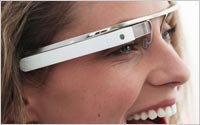Commentary
The Glass House Google Built Being Built By Others
- by Laurie Sullivan , Staff Writer @lauriesullivan, January 2, 2013
 What if your eyes recorded everything you see and the length of time in which you linger on a specific object? How would search marketers use
that data to target ads and content? Diversify. It will become every marketer's strategy in 2013. I'm not referring to diversification of stock portfolios, but rather support for search engine
marketing campaigns through cloud computing and artificial intelligence.
What if your eyes recorded everything you see and the length of time in which you linger on a specific object? How would search marketers use
that data to target ads and content? Diversify. It will become every marketer's strategy in 2013. I'm not referring to diversification of stock portfolios, but rather support for search engine
marketing campaigns through cloud computing and artificial intelligence.
Work backwards through Google's push toward a paperless society and cloud computing initiatives that will prompt consumers to spend more time online -- not only through desktop and smartphones, but other mobile devices like Project Glass.
Google soon will send the first round of augmented reality Google Glass devices, Project Glass, to developers who paid a whopping $1,500 to receive an early prototype version during the company's i/o conference last year. The biggest challenge -- battery life -- will require the glasses to reach past the six-hour lifespan to more than a day. Developers expect the price to drop as more make their way into the market.
Google may have sparked interest in wearable computing that records visual perceptions through location detection, tracking and computer vision, but others are working on similar toys. Most of the components required to build the glasses are found today in smartphones, such as processor, accelerometers, camera, and network interfaces.
"The real challenge is to pack all those elements into a wearable system that can present images close to the eye," according to Rod Furlan, investor and artificial intelligence expert, who set out to make his own pair.
Furlan provides a laundry list of components and processes to build the glasses, such as a microdisplay with a screen between 0.3 and 0.6 inches diagonally, and resolution of at least 320 by 240 pixels. He settles for using a fourth-generation iPod Touch to run the system, but the glasses require the development of something much smaller. The iPod required him to build the system in two parts. He is already building a second version of his prototype based on Raspberry Pi.
The sensation could become addictive. "My world changed the day I first wore my prototype. At first there was disappointment -- my software was rudimentary, and the video cable running down to the onboard computer was a compromise I wasn’t particularly pleased with," Furlan wrote. "Then there was discomfort, as I felt overwhelmed while trying to hold a conversation as information from the Internet (notifications, server statuses, stock prices, and messages) was streamed to me through the micro-display. But when the batteries drained a few hours later and I took the prototype off, I had a feeling of loss. It was as if one of my senses had been taken away from me, which was something I certainly didn’t anticipate."
Furlan believes the greatest value will become second-generation applications that provide total recall and augmented cognition. Imagine being able to call up and share physical vision -- or read the transcripts for every conversation, complete with names and faces of everyone you meet.



